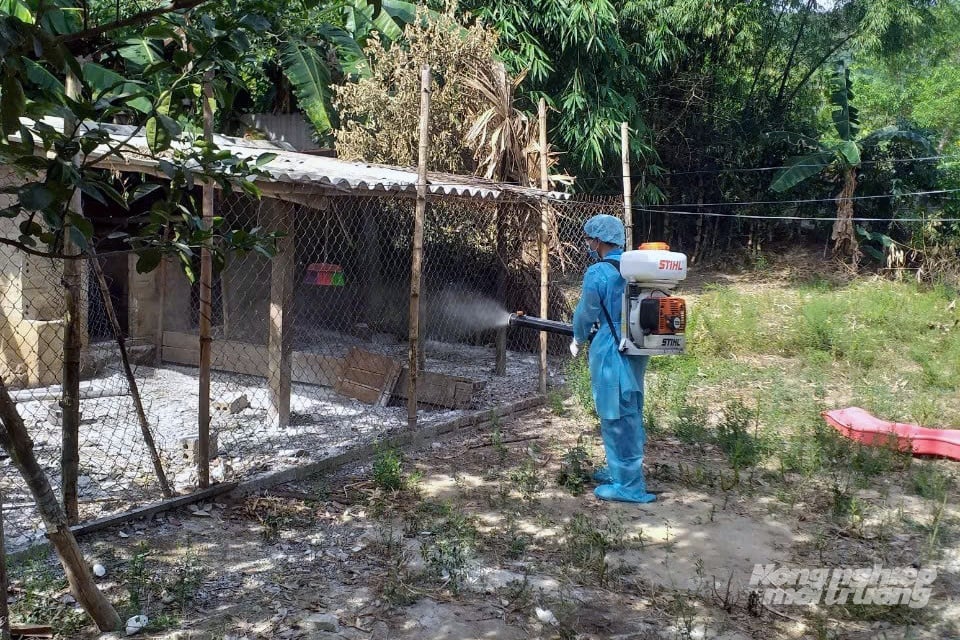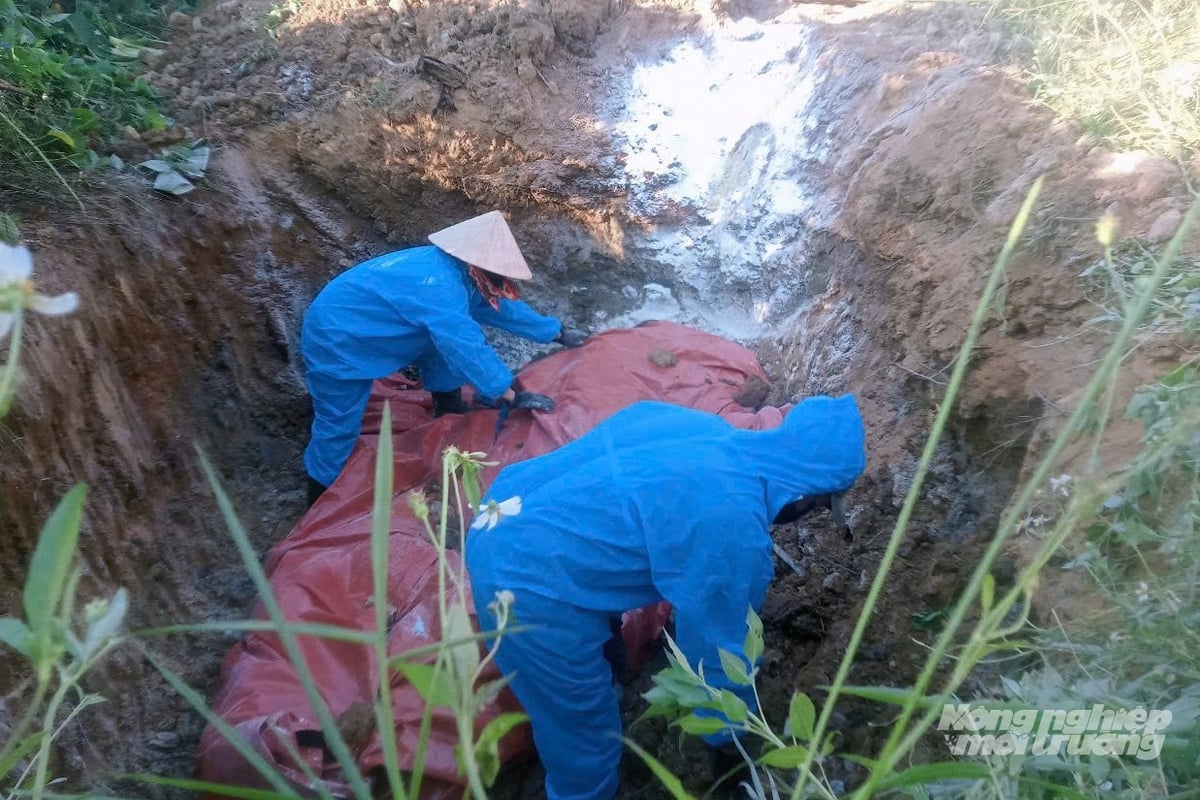December 31, 2025 | 05:06 GMT +7
December 31, 2025 | 05:06 GMT +7
Hotline: 0913.378.918
December 31, 2025 | 05:06 GMT +7
Hotline: 0913.378.918

Localities in Quang Tri are drastically implementing plans to prevent African swine fever. Photo: Vo Dung.
A recent report from Quang Tri Sub-Department of Livestock Production and Animal Health shows that from July 18 to 20, 2025, a total of 1,322 pigs infected with African swine fever were destroyed.
As of July 20, African swine fever had occurred in 631 households/91 villages/16 communes including Kim Phu, Tan Thanh, Dong Le, Tan Gianh, Quang Trach, Phong Nha, Tuyen Lam, Tuyen Son, Trung Thuan, Hoa Trach, Con Tien, Minh Hoa, Dan Hoa, Tuyen Hoa, Nam Gianh and Nam Ba Don. Authorities had to destroy 4,626 pigs with a total weight of nearly 273 tons. Currently, only Kim Phu commune has gone 21 days without a new outbreak. The whole province still has 15 outbreaks of African swine fever.
Quang Trach is the commune with the greatest damage caused by African swine fever. As of July 20, this locality had to destroy nearly 2,000 pigs in 234 households infected with the disease, equivalent to a total loss of more than 113 tons (nearly 42% of the total weight of pigs that had to be destroyed in the whole province).
According to Tran Quoc Tuan, Vice Chairman of the People's Committee of Quang Trach commune, the locality is currently facing many difficulties in terms of human resources, funding and materials for disease prevention work. Quang Trach shares the border with many other communes, so the risk of African swine fever spreading is very high.
The hard, hilly areas make it impossible for local farmers to dig holes themselves, so they have to hire specialized machines to dig long trenches for the collection and destruction of infected pigs. Villages in the commune have contracted digging units, choosing locations far from residential areas. Sometimes there are too many dead pigs that the people have no time to bury them manually, so digging a reserve trench is the only option.
“The commune has only one officer in charge of livestock production and animal health, covering a large area of 13 villages. After the outbreak of African swine fever, Ba Don Livestock Production and Animal Health Station No. 2 increased its forces to coordinate disease prevention. However, there were times when African swine fever appeared in many villages at the same time, so the distribution of human resources was still very difficult,” said Tuan.
While the budget has not been allocated and most of the requests are for chemical support from the Quang Tri Sub-Department of Livestock Production and Animal Health, Quang Trach had to mobilize the participation of mass organizations, youth, women, farmers, militia, and even proposed the police and military forces to support epidemic prevention work.

Disease prevention work currently faces ample difficulties due to a lack of human and financial resources. Photo: Vo Dung.
Another reason for the difficulty in preventing African swine fever comes from a lack of responsibility among livestock farmers. During the early stages of the African swine fever epidemic, some livestock farmers in Quang Trach commune dumped diseased pig carcasses haphazardly, forcing the villages to mobilize machinery to collect and destroy them. Thanks to increased advocacy communication, the community is more aware of the situation, and thus this behavior is no longer to be seen within the commune’s land.
In the case of Le Ninh commune, the situation of diseased pig carcasses being dumped haphazardly also occurred. According to information from a representative of Le Ninh commune police, from late June to early July, people discovered a spot where dead pigs were dumped haphazardly, each weighing from several dozen to hundreds of kilograms, polluting the environment and raising the risk of disease spread to small-scale farms. On July 20, Le Ninh commune police coordinated with militia forces to patrol, control, and set up a temporary quarantine checkpoint. "When the forces got involved, the situation of dumping pig carcasses has decreased significantly," he said.
Using the reserve budget to purchase chemicals and supplies for epidemic prevention
In order to effectively prevent African swine fever, Quang Tri Sub-Department of Livestock Production and Animal Health has directed officers from the Livestock Production and Animal Health Stations to coordinate with localities, provide support in diagnosis, collect and send samples for testing.
Many officers have directly joined the localities in implementing prevention measures. The Sub-Department has also developed a plan on using the reserve budget to purchase chemicals for epidemic prevention to submit to the Department of Agriculture and Environment.
Translated by Samuel Pham

(VAN) From extensive shrimp ponds, baskets of don gathered on the mudflats, to boats carrying visitors to watch birds, all livelihoods here depend on clean water, green forests, and the calls of migratory birds.
/2025/12/26/0703-3-204813_117.jpg)
(VAN) Transparency in information and listening to local people have helped address ground clearance bottlenecks and build social consensus, thereby accelerating the progress of the JICA3 irrigation project.
/2025/12/27/0609-3-233846_327.jpg)
(VAN) The JICA3 project is expected to become a 'water shield,' helping control saltwater intrusion, proactively secure water resources, protect livelihoods, and promote sustainable development in coastal areas.
/2025/12/26/5654-3-164509_655.jpg)
(VAN) As Viet Nam makes strong commitments toward achieving net-zero emissions, controlling and reducing methane emissions in livestock production is increasingly becoming a mandatory requirement.

(VAN) 'People, Primates, Plants: Co-managing Biodiversity and Improving Livelihoods in Vietnam' (the PPP Project) is an international initiative implemented in Vietnam by BGCI, CEGORN, and ICRAF/World Agroforestry.

(VAN) Dak Nong established a risk-level zoning map for coffee, built a digital data platform for the sector, and promoted certified production in line with EUDR.
/2025/12/25/2709-1-211551_295.jpg)
(VAN) In response to the U.S. Marine Mammal Protection Act (MMPA), Gia Lai province is implementing many solutions to protect marine mammals and develop sustainable, responsible fisheries.